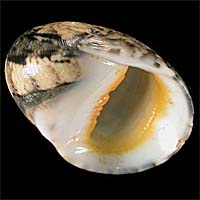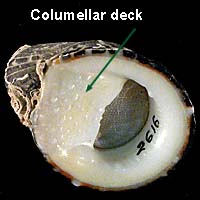|
< Previous family introduction |
|
|||||
 |
Family Neritidae Nerites
|
|||||
|
The Neritidae is a worldwide family, mainly tropical and subtropical, but with significant representatives in temperate seas. As well as occurring in marine and estuarine situations, in the tropics they also live in freshwater. On tropical and subtropical coasts they are among the most abundant of intertidal molluscs. Most species of Nerita live on rocky shores and coral reefs, often exposed to the heat of the sun, or sheltering in crevices or under rocks and seaweed. They are usually active when wet or washed by the rising or falling tide. Neritids are mostly herbivores, grazing on the thin layer of algae on rock surfaces. In estuaries, species of Nerita and Neritina live on rocks, wood and mangrove roots, being either herbivorous or carnivorous, including food such as fly larvae in their diet. Smaragdia souverbiana lives on seagrasses in estuaries, presumably eating microalgae from the plant surface. Shells are low-spired with a swollen last whorl and D-shaped calcareous operculum. The species that live on exposed rocky shores are heavy shelled to resist desiccation and to provide protection against predators. There is variation in shell shape within populations in some species, and colour is very variable in some of the tropical species. In some groups the internal whorls are resorbed to provide space for internal organs. In this family, the sexes are separate and fertilisation is internal. The male bears a penis located on the right side of the head, used to transfer sperm to the female. In marine species the females deposits egg capsules on rocks or other shells, from which larvae hatch into the sea. After a period in the plankton, larvae settle out and begin growth as juveniles. The NSW fauna of this family consists of eight species, seven of which are widespread in the tropical Indo-West Pacific region. These reach into NSW to varying degrees; some only rarely reach into the north of the state, others extend to Sydney, and one species reaches Twofold Bay in the far south. The eighth species, Nerita atramentosa, has a temperate Australian distribution, and is one of the most common molluscs on intertidal rocky shores in temperate Australia. In terms of habitat, two species occur in mangroves, at least one species of Smaragdia occurs on seagrasses in estuaries, and the remaining species occur on rocky shores of the open coast. Family Reference: Komatsu, S. 1986. Taxonomic revision of the neritid gastropods. Special publication of the Mukaishima Marine Biological Station 1-69. In addition to the species illustrated, the following species is recorded from NSW: Neritina violacea (Gmelin, 1791). Western and central Indo-West Pacific. In eastern Australia, a continuous distribution as far south as Noosa Heads, then one record of live animals from Coffs Harbour. Identification Notes: A structure peculiar to the nerites is the columellar deck, the calloused, flattened area bordering the columella on the underside of the shell. The sculpture of this area is one of the most useful identification features in this family, as it may be smooth, or pustulose (i.e. with small bumps), or lirate (i.e. with lines or ridges). The operculum is calcareous, and its sculpture is another useful identification feature. External colour in tropical nerites is quite variable, and of limited use in identification. |
|||||
 |